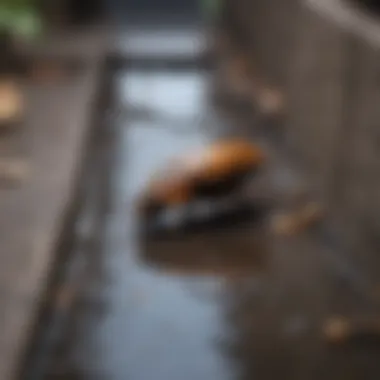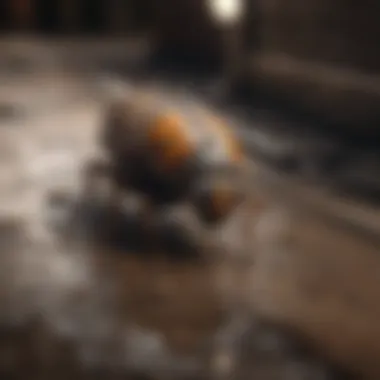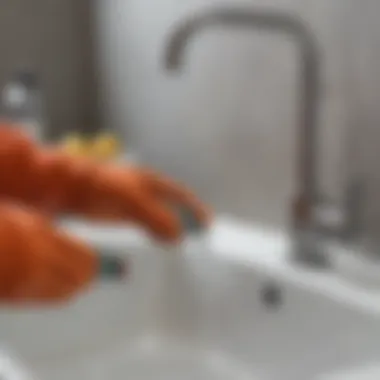Expert Guide: How to Eliminate Drain Bugs Effectively


Methods to Eliminate Bugs from Drains
Drains are often infested with pesky bugs that can be a nuisance to deal with. In this comprehensive guide, we will explore effective methods to get rid of these insects and prevent future infestations. By understanding the common bugs found in drains and implementing preventive measures, you can maintain a clean and bug-free environment in your home.
Identifying Common Drain Bugs
Before opting for a solution, it is crucial to identify the type of bugs infesting your drains. Common bugs include fruit flies, drain flies, and cockroaches. Fruit flies are tiny insects attracted to decaying organic matter, drain flies thrive in moist environments, and cockroaches seek dark, damp spaces. By recognizing these pests, you can choose the most suitable method to eliminate them.
Effective Elimination Methods
Once you have identified the bugs, it is essential to select an appropriate method to get rid of them. For fruit flies, creating vinegar traps can be effective, while drain flies can be eliminated by cleaning and sanitizing the drains with a mixture of baking soda and vinegar. Cockroaches may require the use of insecticidal baits or traps. It's crucial to follow the instructions carefully to ensure successful elimination.
Preventative Measures for Future Infestations
To prevent bugs from returning, it is essential to adopt preventive measures. Regularly clean your drains using a mixture of hot water and bleach to remove any organic buildup that attracts insects. Fix any leaks or standing water sources near drains to eliminate moisture, which is a breeding ground for bugs. Additionally, installing drain covers can help prevent insects from entering your drains and causing infestations.
Conclusion
Understanding Common Bugs in Drains
Understanding common bugs in drains is crucial in addressing pest issues effectively. By delving into the world of drain-dwelling insects, individuals can pinpoint the exact problem they face, whether it's cockroaches, drain flies, fruit flies, or silverfish. This knowledge forms the foundation for implementing targeted solutions to eradicate these pests from the root.
Types of Bugs Found in Drains
Cockroaches
Cockroaches are notorious for their resistance and adaptability, making them formidable foes in the battle against household pests. Their rapid reproduction rates and ability to survive in various environments make them a challenging pest to combat. Cockroaches can carry diseases and trigger allergies, posing serious health risks to occupants.
Drain Flies
Drain flies are small insects with a distinctive appearance, often congregating near plumbing fixtures. While they do not bite humans, their presence indicates underlying drainage issues. Drain flies thrive in moist environments, laying eggs in gelatinous organic matter within drains. Eliminating their breeding grounds is essential to prevent infestations.
Fruit Flies
Fruit flies are attracted to decaying organic matter, especially fruits and vegetables. These tiny insects can infiltrate homes through open windows and doors, making kitchen spaces vulnerable to infestations. Fruit flies multiply rapidly, making swift intervention imperative to prevent widespread proliferation.


Silverfish
Silverfish are nocturnal insects that prefer damp, dark areas like drains and basements. While they do not pose significant health risks to humans, their presence can indicate excessive moisture levels in a property. Removing silverfish entails addressing underlying moisture issues to deter their return.
Identifying Bug Infestations
Odors
Unpleasant odors emanating from drains are a common sign of bug infestations. The putrid smell often indicates decaying organic matter or stagnant water where pests thrive. Identifying and addressing the source of these odors is vital for effective pest control.
Visible Bugs
Spotting live bugs near drains or their discarded exoskeletons signals an active infestation. Visible bugs may include adult insects, larvae, or eggs, providing visual confirmation of the pest problem. Prompt action is necessary to prevent the infestation from spreading.
Slow Drainage
Drainage issues such as slow water flow or gurgling noises can signify a bug infestation in drains. Blockages caused by pest-related debris can impede wastewater flow, leading to backups and foul odors. Resolving drainage problems promptly improves sanitation and disrupts the pests' habitat.
Causes of Bug Infestations in Drains
Food Residues
Accumulated food residues in drains serve as a food source for pests, attracting cockroaches, drain flies, and other insects. Proper disposal of organic waste and routine cleaning of kitchen sinks prevent pests from accessing nourishment, deterring infestations.
Standing Water
Stagnant water in drains creates an ideal breeding ground for insects like drain flies and mosquitoes. Leaks or poor drainage maintenance contribute to water accumulation, fostering pest activity. Addressing water pooling issues and ensuring proper drainage reduces pest attraction.
Poor Drainage Maintenance
Neglected drain systems with clogs, leaks, or lacks of proper ventilation allow bugs to thrive undisturbed. Inadequate maintenance provides insects with shelter, food, and moisture, facilitating their population growth. Regular inspections and upkeep of drains are essential for preventing pest infestations.
Effective Removal Methods
When tackling bug infestations in drains, having effective removal methods is crucial. Proper elimination of bugs not only resolves the current issue but also helps in preventing future reappearances. This section delves into various strategies and techniques for eradicating bugs from drains. Understanding the importance of choosing the right method based on the type of infestation can significantly impact the success of bug removal processes, ensuring a long-term solution to this common nuisance.


Natural Remedies
Baking Soda and Vinegar
One of the most popular natural remedies for bug removal is the combination of baking soda and vinegar. This dynamic duo works by creating a fizzing reaction that helps break down organic matter causing clogs and attracting bugs in drains. The effervescence serves as a natural cleaning solution, effectively removing bugs while deodorizing the drain. The non-toxic nature of baking soda and vinegar makes it an environmentally friendly and safe choice for households looking to eliminate bugs without harsh chemicals.
Boiling Water
Boiling water is a simple yet powerful method for bug removal in drains. Pouring boiling water down the drain helps dislodge and flush out insects and larvae, effectively clearing the infestation. Its heat properties not only eliminate bugs but also sanitize the drain, reducing the likelihood of bug recurrence. However, caution must be exercised when using boiling water to prevent damaging certain types of pipes.
Essential Oils
Essential oils such as tea tree oil, lavender oil, or eucalyptus oil are known for their insect-repelling properties. When used in drains, these oils act as a natural bug deterrent, creating an inhospitable environment for pests. Their pleasant aroma also helps in masking unpleasant odors that attract bugs. While essential oils are a great natural remedy for bug removal, it's essential to dilute them properly to prevent damage to pipes and surfaces.
Chemical Solutions
Commercial Drain Cleaners
Commercial drain cleaners are potent solutions formulated to dissolve clogs and organic matter in drains. These cleaners contain chemicals that break down bug habitats and effectively eliminate infestations. While highly effective, commercial drain cleaners may contain harsh ingredients that can be harmful if not used correctly. It's essential to follow manufacturer instructions and safety guidelines when using these products to ensure safe and efficient bug removal.
Pesticides (Used Sparingly)
In severe bug infestation cases, pesticides can be used as a last resort for bug removal. However, it is important to use pesticides sparingly and as a targeted treatment to minimize environmental impact and health risks. Proper care must be taken when using pesticides in drains to prevent contamination of water sources and exposure to pets or humans. Consulting with a professional exterminator before resorting to pesticides is recommended to determine the safest and most effective approach.
Mechanical Removal Techniques
Plumbing Snake
A plumbing snake, also known as a drain snake or auger, is a tool designed to unclog drains by physically breaking through blockages. When dealing with bug infestations, a plumbing snake can dislodge debris and insect nests, allowing for a clear passage of water. This mechanical method of bug removal is effective for stubborn infestations that cannot be resolved with traditional cleaning methods. However, using a plumbing snake requires proper technique to avoid damaging pipes or worsening blockages.
Plunger
A plunger is a versatile tool that can be used to dislodge bugs and debris from drain pipes by creating pressure and suction. By creating a vacuum effect, plungers can help clear clogs and remove insects causing blockages. When using a plunger for bug removal, ensure a tight seal around the drain opening to maximize suction power and effectiveness. Regular maintenance and cleaning of the plunger after use are essential to prevent the spread of bacteria and contaminants.
Preventative Measures for Long-Term Success


In this segment, we delve into the critical aspect of Preventative Measures for Long-Term Success in combating bugs in drains. Emphasizing these preventive strategies is paramount to ensuring a bug-free environment in the long run. By implementing preventive measures, individuals can proactively address bug infestations before they escalate, saving time, effort, and potentially costly interventions. These measures not only tackle existing bug issues but also aim to prevent future infestations from occurring, creating a more hygienic and comfortable living space.
Regular Maintenance Practices
- Flush with Hot Water: The practice of flushing drains with hot water is a fundamental step in maintaining drain hygiene. Hot water helps dissolve grease, food residues, and other organic matter that may attract bugs. This simple yet effective method can help prevent clogs and minimize the conditions conducive to bug infestations. Consistent hot water flushes can also dislodge debris accumulating in the pipes, promoting better drainage and reducing the risk of stagnant water pools that attract bugs.
- Use Drain Covers: Installing drain covers serves as a proactive measure against bugs entering the drains. These covers act as barriers, preventing bugs from accessing the drain pipes and creating breeding grounds. Drain covers are easy to install, affordable, and come in various sizes to fit different drain openings. By blocking bug entry points, drain covers help maintain cleanliness, reduce potential infestation sources, and simplify cleaning and maintenance efforts.
- Dispose of Food Properly: Proper disposal of food scraps and leftovers plays a crucial role in bug prevention. Avoiding food accumulation in drains reduces the attractiveness of these areas to bugs seeking nourishment. By disposing of food waste in designated bins or compost piles instead of the sink, individuals can mitigate the risk of bug infestations. Regularly cleaning food particles from dishes, sinks, and garbage disposals further reduces bug-friendly environments and promotes overall sanitation in the kitchen and bathroom.
Environmental Modifications
- Fix Leaks: Addressing and repairing any water leaks in plumbing fixtures is essential for bug prevention. Moist environments resulting from leaks create ideal conditions for bugs to thrive. Fixing leaks not only eliminates standing water sources but also contributes to water conservation and lower utility bills. Timely leak detection and repair safeguard against structural damage, mold growth, and bug infestations, promoting a healthier living environment.
- Reduce Moisture: Decreasing moisture levels within and around the drain area can deter bugs from setting up colonies. High humidity and dampness attract bugs like drain flies and silverfish, making moisture reduction a key preventive strategy. Strategies such as using dehumidifiers, proper ventilation, and fixing dripping faucets or condensation issues help in lowering moisture levels. By creating a drier environment, individuals can make their homes less hospitable to bugs, reducing the likelihood of infestations.
- Ventilate Properly: Proper ventilation is crucial in maintaining optimal indoor air quality and reducing bug-friendly conditions. Adequate ventilation helps regulate humidity levels, prevent musty odors, and improve overall air circulation, discouraging bugs from congregating in damp, poorly ventilated spaces. Ensuring proper ventilation in bathrooms, kitchens, and other moisture-prone areas promotes a healthier living environment, minimizes mold growth, and contributes to effective bug prevention.
Seeking Professional Help
Seeking professional help in dealing with bugs in the drain is a crucial step towards ensuring effective elimination and prevention. Pest control experts bring in-depth knowledge and experience to tackle persistent bug infestations that household remedies may struggle to eradicate. By engaging professionals, individuals can benefit from tailored solutions that target specific bug species and infestation levels. Moreover, exterminators use advanced techniques and tools to address bug issues effectively, reducing the risk of future recurrences.
When to Consult Exterminators
Persistent Infestations
Persistent bug infestations pose a significant challenge for homeowners, indicating a deeper-rooted issue that requires professional intervention. Exterminators are equipped to handle complex infestations that may not respond to simple DIY methods. Their thorough assessment and treatment plans target the source of the problem, ensuring long-term bug elimination. While professional services incur a cost, the peace of mind and guaranteed results they offer make them a worthwhile investment in maintaining a bug-free environment.
Unidentifiable Bugs
Dealing with unidentifiable bugs can be a daunting task, as their mysterious nature complicates effective elimination strategies. Exterminators excel in identifying unknown bug species through specialized knowledge and tools, allowing for precise treatment approaches. By avoiding guesswork and utilizing targeted solutions, professionals can safeguard homes from potential health hazards and structural damage caused by unidentified bugs.
Health Concerns
Health concerns related to bug infestations, such as allergies, infections, and respiratory issues, underscore the importance of prompt and thorough bug removal. Exterminators play a vital role in minimizing health risks associated with bugs in the drain. Their expertise ensures the safe and effective extermination of bugs, creating a hygienic living environment that promotes overall well-being.
Importance of Timely Intervention
Avoiding Property Damage
Timely bug intervention is key to preventing property damage that bugs can cause if left unchecked. Bugs like cockroaches, drain flies, and silverfish can infiltrate household structures, compromising aesthetics and functionality. Exterminators act swiftly to eliminate bugs and limit their destructive impact on property, preserving the integrity of homes and minimizing repair costs.
Ensuring Hygiene
Maintaining hygiene standards is essential in bug control efforts to prevent contamination and health risks. Professional extermination services uphold hygiene protocols during bug removal, ensuring that affected areas are thoroughly cleaned and disinfected. By prioritizing hygiene, exterminators safeguard residents from potential diseases and maintain a sanitary living environment.
Preventing Structural Issues
Bug infestations in drains can compromise the structural integrity of buildings over time, leading to costly repairs and renovations. Exterminators employ proactive measures to prevent bugs from causing structural damage, preserving the longevity of properties. Through timely interventions and preventive treatments, professionals help mitigate the risk of structural issues associated with persistent bug infestations.







